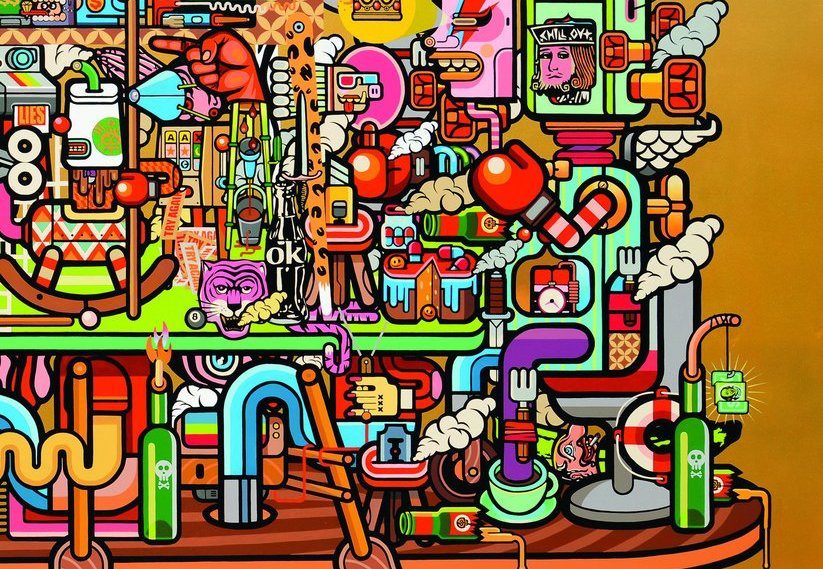In November 2017, The Australian newspaper’s Review featured “the launch of Indonesia’s first large-scale contemporary art museum”, the Museum of Modern and Contemporary Art in Nusantara. Known by its acronym, the Museum MACAN, it is hailed as the first gallery of its kind and is privately funded by Indonesian philanthropist Haryanto Adikoesoemo. The director appointed to lead this venture is Australian Aaron Seeto, who comes with experience as curatorial manager of Brisbane’s highly successful 2015 Asia-Pacific Triennial. Seeto explained that Mr Adikoesoemo “understands this is a museum for all of Indonesia: that is why education is a big part of it…. We know that in a place like Indonesia that is multi-ethnic and multi-racial, art and culture help people to better understand their own societies and their histories.” The Museum MACAN project underlines the importance of Indonesia’s contemporary art to all Indonesians—and for others seeking to better understand Indonesia.
By coincidence a new book on Indonesian contemporary art, also acknowledging its importance to better understanding present day Indonesia, came out earlier in 2017. Dr Yvonne Spielmann’s Contemporary Indonesian Art: Artists, Art Spaces, and Collectors appeared first in German in 2015. With the support of the Nanyang Technical University Centre for Contemporary Art, Goethe-Institut Singapore, and Indonesian art collector Deddy Kusuma, it has been translated into English.[1] Dr Spielmann specialises in new media and intercultural communication and was Dean of the Faculty of Fine Arts at LASALLE College of the Arts, Singapore. This put her close to the commercial centres of the regional art market represented by branches of international auction houses Christie’s and Sotheby’s in Singapore and Hong Kong. Her book begins with their contribution to the internationalisation of contemporary Indonesian art.
This review will describe Dr Spielmann’s presentation of ‘contemporary Indonesian art’ and evaluate its strengths and weaknesses. It also takes her topic a little further by looking more closely at why Indonesian contemporary art is relevant to our understanding of Indonesian culture, society, and history.
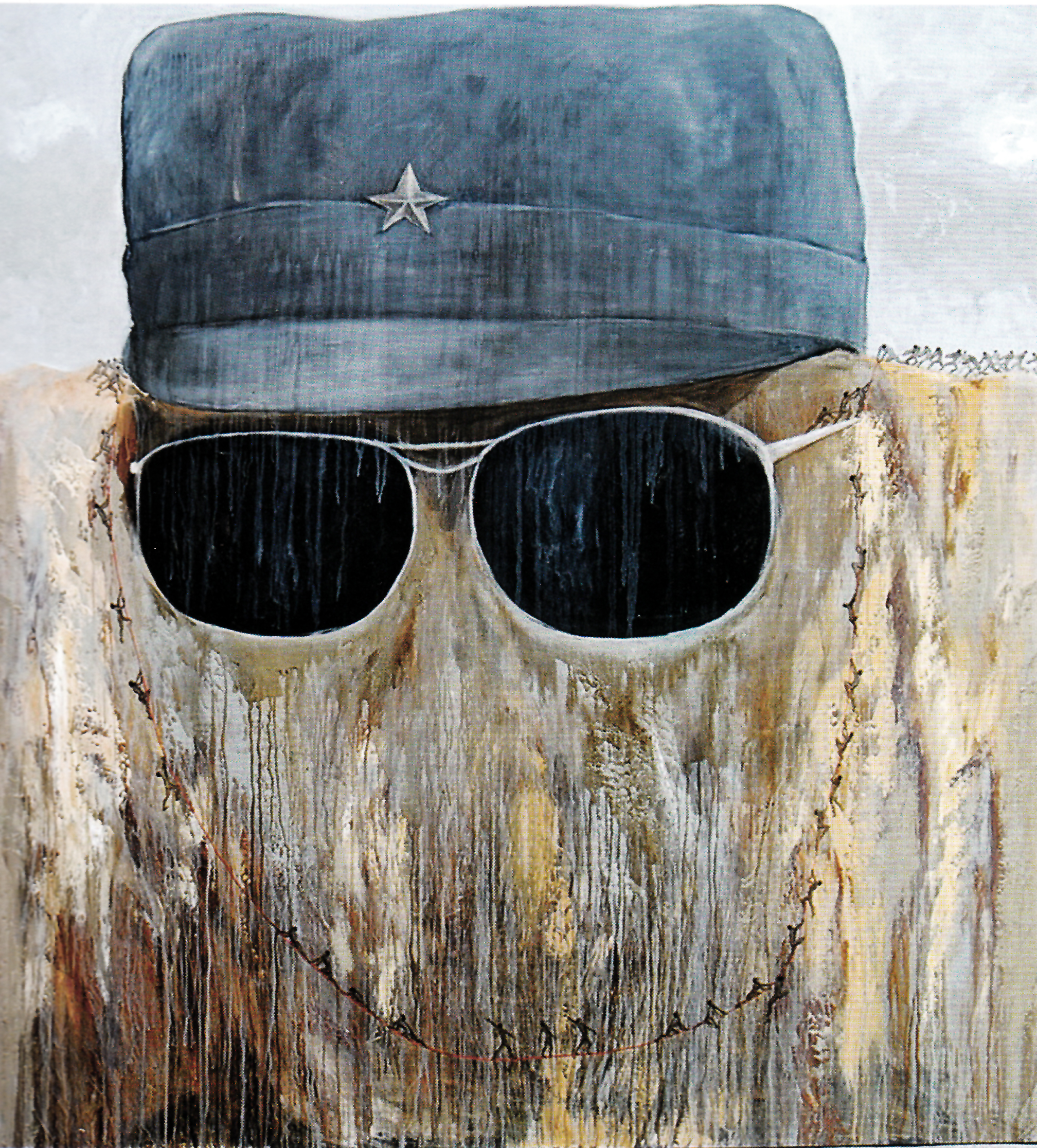
One of Putu Satiwijaya’s paintings featuring the face of Soeharto (image via Indonesian National Gallery)
From the 1990s, Dr Spielmann writes, dealers, curators and collectors increasingly acquired works by Indonesian artists. By the mid-2000s, the international art market reflected this interest and in 2007 and 2009, paintings by two Indonesian artists Putu Sutawijaya and I Nyoman Masriadi sold for the record-breaking prices of US$90,000 and more than one million US dollars respectively. After a brief discussion of the two artists, Dr Spielmann takes her readers into the narrative with only a table of contents to guide them.
Dr Spielmann divides her book into three substantial chapters: “Contemporary Indonesian Art in the Southeast Asian Context”; “Positions in Modern and Contemporary Art”; and “Aesthetics of Reflection and Transformation”. Each chapter is self-contained and can be read independently of the others. Selective readers can use the index to go straight to the material that interests them but a reader who engages with the book as a whole will be irritated by the repetition of information already given in the previous chapters.
The first chapter, “Contemporary Art in the Southeast Asia Context”, moves from the investment value of works by well-known contemporary Indonesian artists to a section on what “contemporary Indonesian art” means. Dr Spielmann indicates the complexity of locating contemporary Indonesian art in its own context as well as the wider regional and global contexts. She supports the views of respected Indonesian artist and art critic/historian, Jim Supangkat, who argues for a definition that recognises diversity, experimental developments, and change as important characteristics of contemporary art.
In the sub-section, “Indonesian Circumstances”, Dr Spielmann explains the origins and orientations of Indonesia’s two state-sponsored tertiary art programs in Bandung and Yogyakarta. She emphasises that although a National Museum and, since 1998, a National Gallery exist as buildings, minimal state funding reaches them. As a result, it is difficult to provide appropriate storage for collections (obviously essential in a tropical climate) and conservation of artworks, let alone outreach or education activities. State-funded galleries also cannot afford to purchase many of Indonesian works auctioned on the international market. This leads to one of the book’s best argued points: that contemporary Indonesian art has been and continues to be nurtured by private collectors and galleries who identify and promote emerging artists, curate and show their works, and publish catalogues that position their works for national and international audiences. It is this private sector that attempts to bridge “the gap between private sponsorship and public neglect.” (p.27).
Chapter One also includes an overview of women artists charting their rise and the challenges they have faced. Several of them appear again in the following two chapters. There is a substantial section, “The Southeast Asia Context”, presenting a wider survey of contemporary art in the Asia-Pacific region. Here Dr Spielmann mentions the major biennials, triennials and art fairs that show contemporary works. These include the pioneering Fukuoka (Japan) Asian Art Triennale started in 1992 and Queensland Art Gallery’s Asia-Pacific Triennial first held in 1993. Dr Spielmann notes that the wider Southeast Asian region, represented by the member states of ASEAN, has shared experiences that are reflected in its contemporary art. She writes, “Much art in the region is critical of societal, economic, and political conditions; many artists put themselves on the line even in times of rigorous censorship and dictatorship. … [I]njustice, repression, inequality, and corruption became topics of discussion, for which purpose regionally and locally engaged artists privileged performance, installation, and video—not primarily as a reaction to the current genres on the commercial art market, but rather as an expression of direct connection with the public.” (pp.27-8). Dr Spielmann provides overviews of the history, styles, leading artists, major art events and galleries that characterise the art of each of the ASEAN member states. Although she lived in Singapore at the time of writing her German version of the book, she pulls no punches about the restrictions facing artists who work there. While acknowledging Singapore’s status as a role-model for arts infrastructure, she points out that it is not a democracy, criminalises criticism of the government, and “imposes restrictions on privacy and expressions of sexuality, nudity and homosexuality and censors artistic performances in the public space.” (p.38).[2]
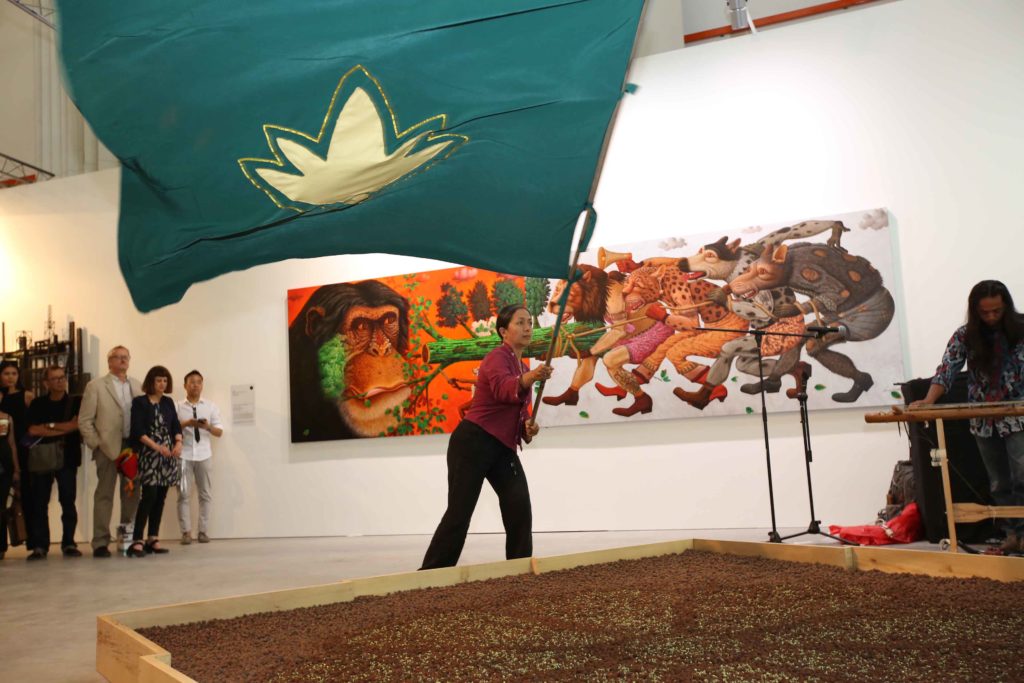
Indonesian artist Arahmaiani Feisal at the Art Stage Singapore’s “Indonesia Pavilion” in 2013. (Photo: Tyler Rollins Fine Art)
There are weaknesses in this section on the regional context. Brunei Darussalam is not included and the information on Malaysia does not mention the many Malaysian artists whose art is inspired by Islam and expressed in a range of media including digital. There is also no mention of the very impressive Islamic Arts Museum of Malaysia (opened 1998). The paintings of Malaysia’s highly respected and very gifted artist, Latiff Mohidin, are misunderstood and dismissed as “far removed from the country’s social and political problems.” (p.37).
Chapter One concludes with the section “Tradition and Identity in Contemporary Indonesian Art” and an appreciation of the pivotal position contemporary Indonesian artists play in the Southeast Asian region. Dr Spielmann quotes from Indonesian art scholar and curator, Rifky Effendy, who describes Indonesia’s emerging artists in the catalogue for Art Stage Singapore. 24–27 Jan 2013 as follows: “[they]… are moving towards conceptual painting, objects, and installations, photography and new media—with themes that focus on issues of identity, environment, religiosity and sociocultural issues, especially how artists respond to globalisation and the complexity of daily sociocultural life.” (p.43).
This quotation from Rifky summarises well the perspective and interests of Indonesia’s next generation of artists.
The middle chapter of the book provides a more detailed history of the pioneers of Indonesian modernism and the establishment and influence of Indonesia’s leading tertiary-level art academies in Bandung and Yogyakarta. To do this in just 20 pages means that Dr Spielmann uses broad-brush generalisations that can be misleading and are occasionally inaccurate. The language is often dense and hard to follow. Describing 1990s debates about the future of Indonesian art, for example, she writes:
A substantial potential for resistance to the “danger” of cooptation in the global postmodern discourse on contemporary art, which is exposed to the reproach of being a new universalism, can be explained, on the one hand, by the delayed beginning of the debate on Modernism and contemporary art in Asia and Indonesia. On the other hand, it aims at maintaining a difference, because the reference to an autonomous Indonesian Modernism, which must be critically appropriated, is still powerfully active and multi-layered. (p.55)
It is with relief that many readers will move from the first section of Chapter Two to its later sections where Dr Spielmann presents beautifully illustrated overviews of Indonesia’s leading modernist artists and describes several stunning private collections. She also continues the descriptions of private galleries already mentioned in her first chapter and underlines their role in the development of contemporary art. She concludes Chapter Two with examples of the wide variety of “art spaces”, art fairs, informal venues, and artists’ collectives that emerge and provide places for “unknown” artists to create and often also distribute their works. Dr Spielmann emphasises the twin aspects of Indonesian art distribution: the privately sponsored, project-oriented independent initiatives and the “increased professionalization through commercial galleries, auction houses, and art fairs in Asia.”
In her third and final chapter, Dr Spielmann seems more comfortable presenting the works of artists she has interviewed and met personally. The chapter begins with another summary of what she terms the “de-Westernisation of aesthetics and discourse” in Indonesian art, material that has already appeared in the previous chapters. It continues with vignette presentations of thirteen artists whose works appear in international collections and exhibitions as well as in Indonesia. The well-placed colour plates allow readers to engage directly with the works and perhaps see in them elements that Dr Spielmann does not mention. Readers may not agree with all of her views, but they will feel they have been offered a diverse and generous selection of major works by Indonesia’s contemporary artists.
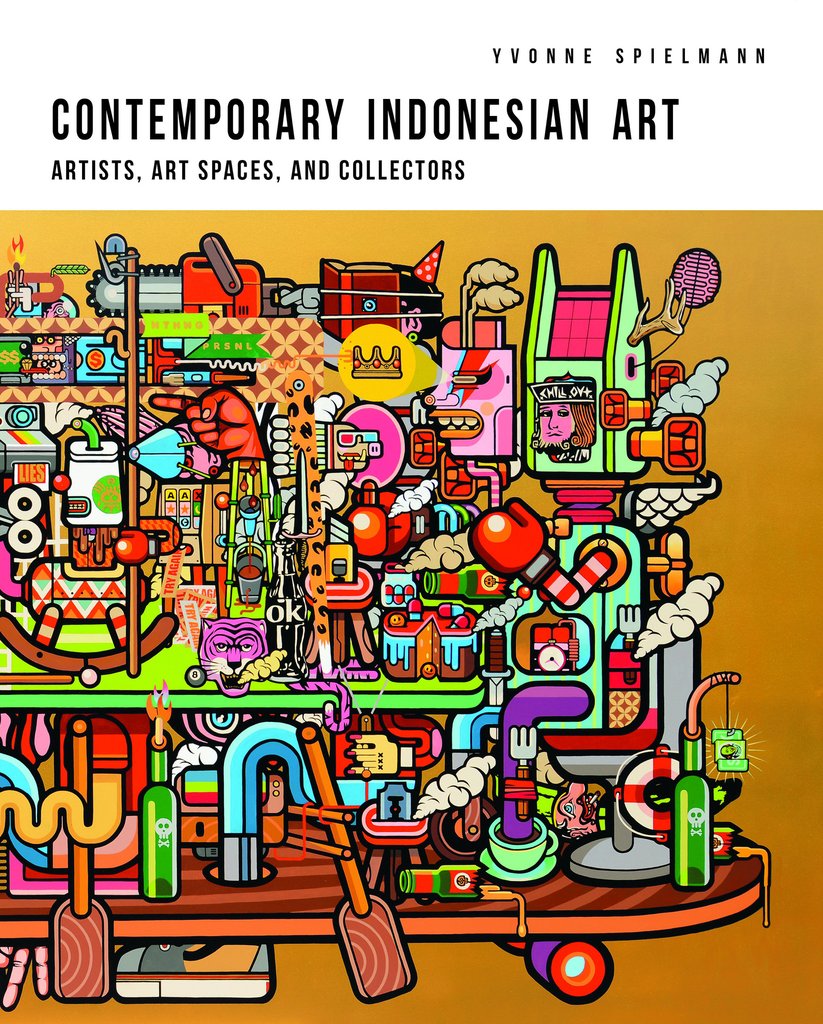 The cover image for Dr Spielmann’s book is a Pythonesque, eclectic, highly-detailed, pop-art version of a giant skateboard crammed with a bizarre mix of objects. Propelled by wheels and paddles, the skateboard’s cargo includes (among many other items) pieces of machinery and plumbing ducts, toys, logos, political symbols, a mosque loudspeaker, chainsaws, weapons and a selection of explosive devices. The “vehicle” may be under the control of a multipurpose robot seated at the rear. Entitled Makan Besar (The Big Meal) it is the work of graphic design and pop art duo the Indieguerillas (Mike Bawono and Santi Ariestyowanti), completed in 2014. As Dr Spielmann notes, they use a style powerfully charged with references. Makan Besar could also serve as a visual image for Dr Spielmann’s book, which like “The Big Meal” tries to balance too much on a limited base and overwhelms the message with an overabundance of detail. Let me briefly explain.
The cover image for Dr Spielmann’s book is a Pythonesque, eclectic, highly-detailed, pop-art version of a giant skateboard crammed with a bizarre mix of objects. Propelled by wheels and paddles, the skateboard’s cargo includes (among many other items) pieces of machinery and plumbing ducts, toys, logos, political symbols, a mosque loudspeaker, chainsaws, weapons and a selection of explosive devices. The “vehicle” may be under the control of a multipurpose robot seated at the rear. Entitled Makan Besar (The Big Meal) it is the work of graphic design and pop art duo the Indieguerillas (Mike Bawono and Santi Ariestyowanti), completed in 2014. As Dr Spielmann notes, they use a style powerfully charged with references. Makan Besar could also serve as a visual image for Dr Spielmann’s book, which like “The Big Meal” tries to balance too much on a limited base and overwhelms the message with an overabundance of detail. Let me briefly explain.
In just 178 pages (including bibliography and index), Dr Spielmann’s Contemporary Indonesian Art: Artists, Art Spaces, and Collectors seeks to present the history of Indonesia’s modern and contemporary art from the end of the colonial period to 2014. This is almost impossible and has, I suggest, been attempted at the expense of the subject. The “classic” account of the origins and development of contemporary art in Indonesia is Astri Wright’s Soul, Spirit, and Mountain: Preoccupations of Contemporary Indonesian Painters (OUP, 1994). Wright’s narrative concludes two decades before 2014, when Dr Spielmann’s book ends, yet Wright’s book is more than double the size. It is based on research undertaken for a Cornell University dissertation, and Wright immersed herself in Indonesia’s art world between 1987 and 1989 to examine the works of over 200 painters. Dr Spielmann was not able to spend such an extended period of intensive contact with her subjects. She relies on secondary sources and personal interviews with only some of those mentioned in her work. She also does not come to her topic as well prepared as Astri Wright, who graduated from Cornell University’s Southeast Asia Program. Nevertheless, a selective comparison of their works helps identify the strengths and weaknesses of Dr Spielmann’s book.
Firstly, as already mentioned, the book lacks an introduction that connects the author with her readers, explains her purpose and what inspired her to write it. Crucially, there is no explanation about the readership she is targeting nor an outline of the structure of the book to guide readers through its sections. Secondly, Astri Wright’s English style is direct, uncluttered and succinct, communicating easily with readers. Unfortunately the opposite is the case with Dr Spielmann’s style, or at least the style in which the English version of her book appears. Perhaps the original German communicates her meaning with greater clarity, but there are too many sentences in the English version that require several readings to extract their meaning. Thirdly, Wright anchors her approach in the metaphor of “the mountain” and that trope is sustained throughout the work and examined from different perspectives and through the diverse ways artists understand and interpret it. Dr Spielmann’s subtitle, “artists, art spaces, and collectors” is an accurate description of her book’s foci. She approaches Indonesia’s contemporary art through its physical manifestations: the artefacts/art works and their creators; the galleries that exhibit them; the commercial networks that buy and sell them; the collections that preserve them; and the teaching institutions that prepare the new generations of artists; and the informal networks that support “alternative” artists. This approach identifies and emphasises the “Indonesian gap” caused by the failure of the state to provide adequate infrastructure to support emerging artists and to exhibit iconic contemporary works. As Dr Spielmann points out, the infrastructure gap is filled by private collectors, galleries, and art spaces. The most recent example of this, opening too late to be included in the book, is the Museum MACAN, funded by an Indonesian philanthropist.
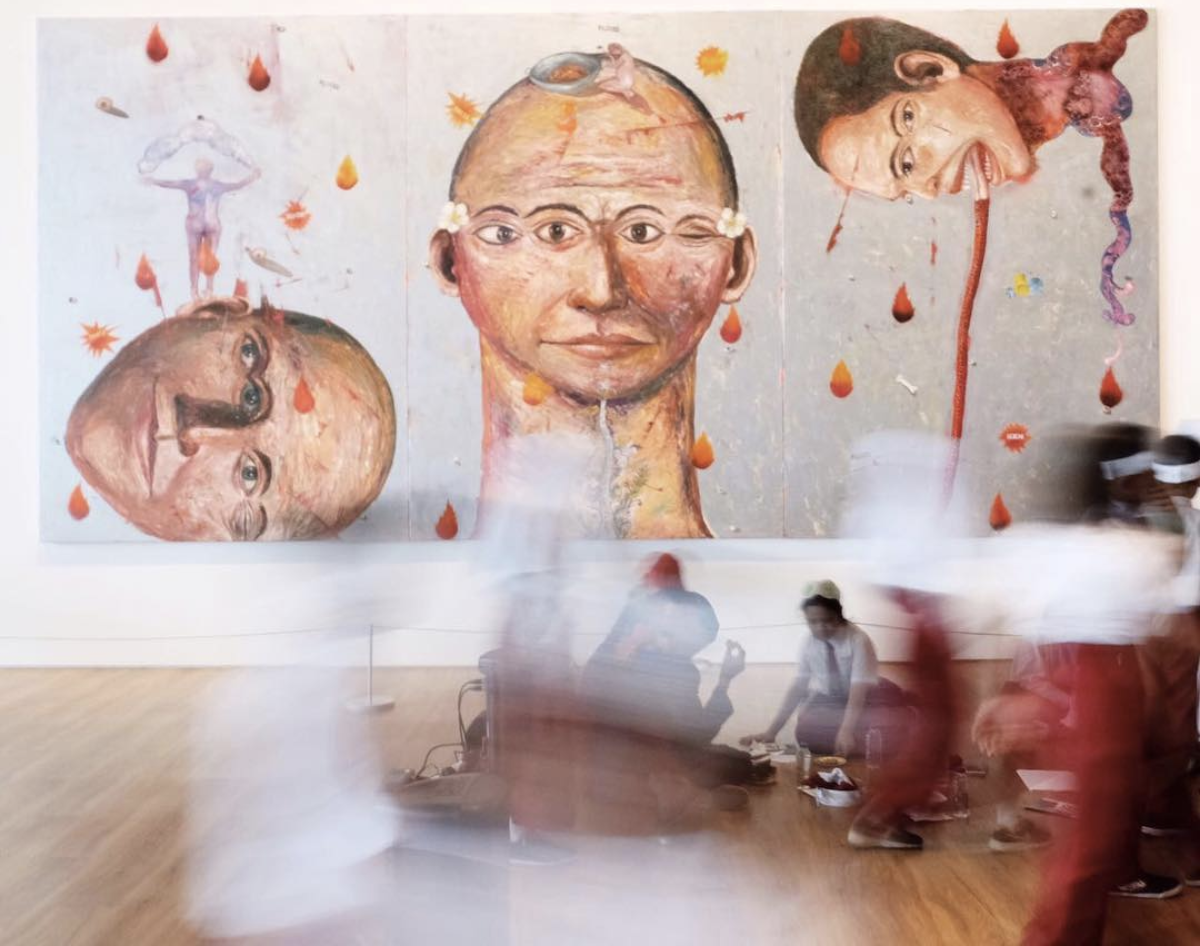
Museum MACAN, Jakarta (photo: @museummacan on Instagram)
Dr Spielmann’s focus on the material and the physical manifestations of contemporary art neglects the deep spirituality that inspires many of Indonesia’s contemporary artists, and is evident throughout Wright’s study. This perhaps explains at least one serious omission in Dr Spielmann’s book—art that is inspired by Islam.[3] This is a surprising omission because the leading Islam-inspired artists, Ahmad Sadali (1924–1987) and A.D. Pirous (1933–), were both Professors in the Fine Arts Department, Institute of Technology Bandung, an art academy mentioned several times in Spielmann’s book. Sadali is regarded as the father of abstract art in Indonesia and his works with those of Pirous are internationally known and fetch high prices at auctions. Edwin Rahardjo of Edwin’s Gallery (referred to several times in Dr Spielmann’s book) has an extensive collection of Sadali’s works. In 1997, Edwin organised a retrospective of Sadali’s paintings, for which Jim Supangkat wrote an excellent catalogue essay in English, entitled Hidden Works and Thoughts of Ahmad Sadali. Edwin has said that he learned to “see” art after spending hours looking at Sadali’s paintings.[4] In 2014, the National Gallery of Indonesia held a major retrospective celebrating Sadali as an Indonesian “Maestro” and showing his influence on the works of contemporary younger artists. A.D. Pirous’s works and philosophy have been deeply and sensitively analysed by Kenneth M. George, Picturing Islam: Art and Ethics in a Muslim Lifeworld (Wiley-Blackwell, 2010). Without reference to these major internationally respected artists, no survey of contemporary Indonesian art is complete.
It is also surprising that Dadang Christanto (1957–), again an internationally recognised Indonesian artist, is given only two cursory mentions in the book. His works, especially his installations, bear witness to the effects of violence and oppression in all forms and in all places, earning him the title “the artist of conscience.”[5] He is represented in major galleries through Southeast Asia and Australia, and his works are regularly selected for the Brisbane’s Asia-Pacific Triennials.
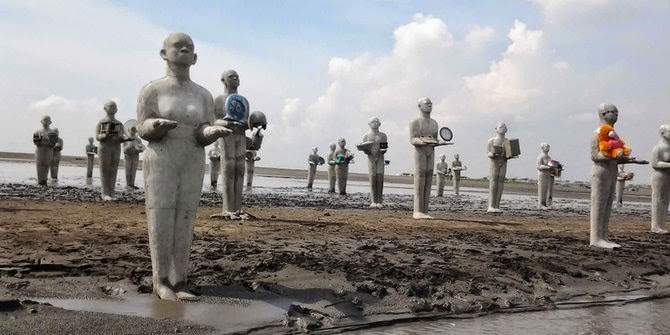
Installation by Dadang Christanto at the site of the Lapindo mud disaster in Sidoarjo, East Java, 2014. (photo: Jurnal Sunardian at blogspot)
Any book seeking to engage with contemporary Indonesian art should be welcomed as a contribution to acknowledging the talent and creativity of Indonesia’s artists and the position they hold in Indonesian society. Most of them feel a responsibility to draw attention to corruption, hypocrisy, oppression, violations of human rights, and destruction of the environment. Dr Spielmann makes this point by quoting the words of Eko Nugroho, master artist and activist. In 2013 he said, “If you live in Indonesia, you will understand that it is impossible to exclude politics from everyday living. Nearly 90% of the art here is a response to or influenced by the socio-political conditions of our surroundings.” (p.153.)
Indonesia’s artists are its intellectuals of the visual. Acutely observant of the political as well as the social aspects of their society, they hone in on abuses of power and the suffering that results. These artists re-invent and play with “tradition” knowing their viewers will understand the innuendos and allusions, using earthy humour and lyrical grace with all shades in between, to exquisitely express their subjects. When censorship, intimidation or even violence is used against them, they are not silenced and continue to create their art. This is why Indonesia’s contemporary art matters.
The book has its weaknesses and it could have been better. Returning to the image of the “Big Meal”, we suggest that some of the items piled on the over-laden skateboard could be jettisoned (especially the duplicates—and here a good editor could lend a hand). The cargo could then be re-packed in better order (with less detail and jargon) and basic art information such as the dimensions and media of each work supplied. And the driver should not begin the journey without telling passengers where they are going and what route they will be taking. Now that the Museum MACAN is open, Indonesians and overseas visitors can see permanent displays of Indonesia’s vibrant contemporary art with their own eyes and also visit Edwin’s Gallery nearby, the oldest private gallery in Jakarta.

Virginia Matheson Hooker is Professor Emeritus and Fellow in the Department of Political and Social Change at the Australian National University’s College of Asia and the Pacific. She retired as Professor of Indonesian and Malay in January 2007. Her research has focused on Islam in Southeast Asia, literature and social change in Malaysia and Indonesia, and Indonesian political culture. Her most recent book, co-edited with Dr Greg Fealy, is an award-winning sourcebook on contemporary Islam in Southeast Asia.
• • • • • • • • • • • • • • •
 Facebook
Facebook  Twitter
Twitter  Soundcloud
Soundcloud  Youtube
Youtube  Rss
Rss 